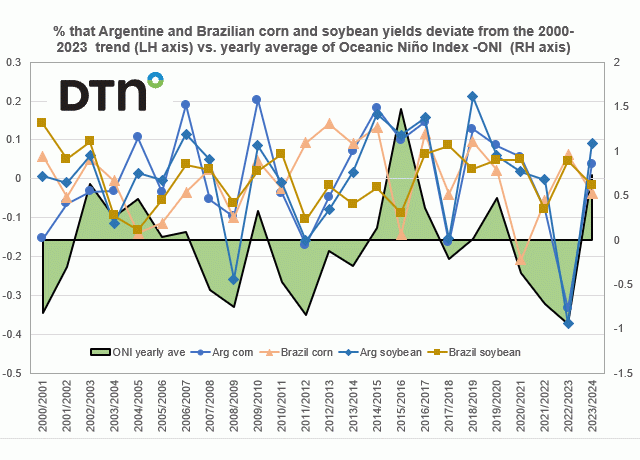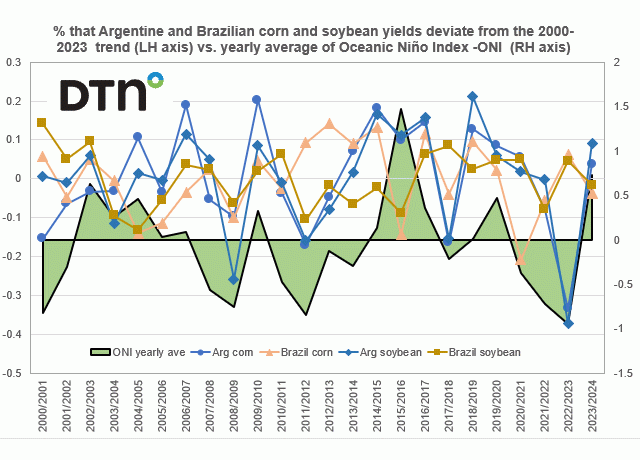Fundamentally Speaking
South American Row Crop Yields
In the January WASDE report released last week, USDA pared the 2023/24 Brazilian soybean crop by 4 million metric tons (mmt) to 157 mmt based on adverse weather conditions, especially in the northern part of the country.
They also cut their projection for the Brazilian corn crop by 2 mmt to 127 mmt on reduced safrinha area expectations.
Meanwhile USDA kept its estimate of Argentina's corn production at 55 mmt though its soybean crop was hiked by 2 mmt to 50.0 mmt.
This is a dramatic turnaround from the year ago figures in Argentina of 34 mmt of corn and 25 mmt of soybeans.
The improved fortunes of the Argentine crop and the less favorable results in Brazil are linked to the transition from La Niña conditions last year to El Niño conditions this season.
P[L1] D[0x0] M[300x250] OOP[F] ADUNIT[] T[]
The severe heat and dryness in Argentina last year was linked to a third year in a row of La Niña that brings cooler-than-average waters to the central and eastern tropical Pacific and often all the way to South America.
In brief, the Oceanic Niño Index (ONI) is NOAA's primary index for tracking the ocean part of ENSO, the El Niño-Southern Oscillation climate pattern.
The ONI is the rolling 3-month average temperature anomaly (or difference) from average in the surface waters of the east-central tropical Pacific, near the International Dateline.
Index values of +0.5 or higher indicate El Niño while values of -0.5 or lower indicate La Niña which are often associated with dry and warm conditions in Argentina while El Niño conditions often bring the same type of stressful weather to Brazil.
Along these lines, this chart shows the percent that Argentine and Brazilian corn and soybean yields deviate from the 2000-2023 trend on the left-hand axis vs the year average of Oceanic Niño Index (ONI) on the right-hand axis.
Forecasters say that the current El Niño should start to fade by spring but that will be too late for the bulk of the Brazilian corn and soybean crops where private analysts have 2023/24 yields pegged much lower than the current USDA estimates.
The current event is quite strong having averaged 1.5 over second half of the year and 0.7 for all of 2023 which is the highest value since the 2014-2016 El Niño.
Note that in years of strong El Niño's, Argentine corn and soybean yields often come in well above trend yet not the case for Brazil.
The 2000-2023 correlation coefficient between ONI and Argentine corn yields is 65.0% and for soybeans 58.4%, yet the correlation between ONI and Brazilian corn yields is -16.1% and for soybeans -15.7%.
It does seem that La Niña events hurt Argentine yields more than El Niño conditions harm Brazilian yields but so far, the current El Niño is leading to some of the best Argentine row crop prospects in years.
Along these lines the Rosario Grain Exchange saying that Argentina is set for a corn and soy "super harvest" with production forecasts likely to keep climbing beyond their current harvest forecasts of 59 mmt of corn and 52 mmt of soybeans.
(c) Copyright 2024 DTN, LLC. All rights reserved.





Comments
To comment, please Log In or Join our Community .